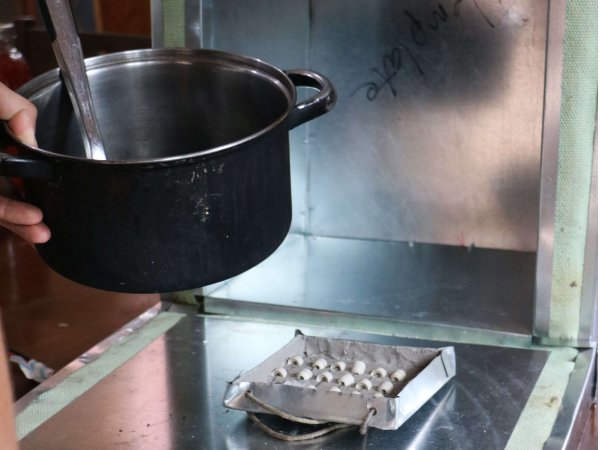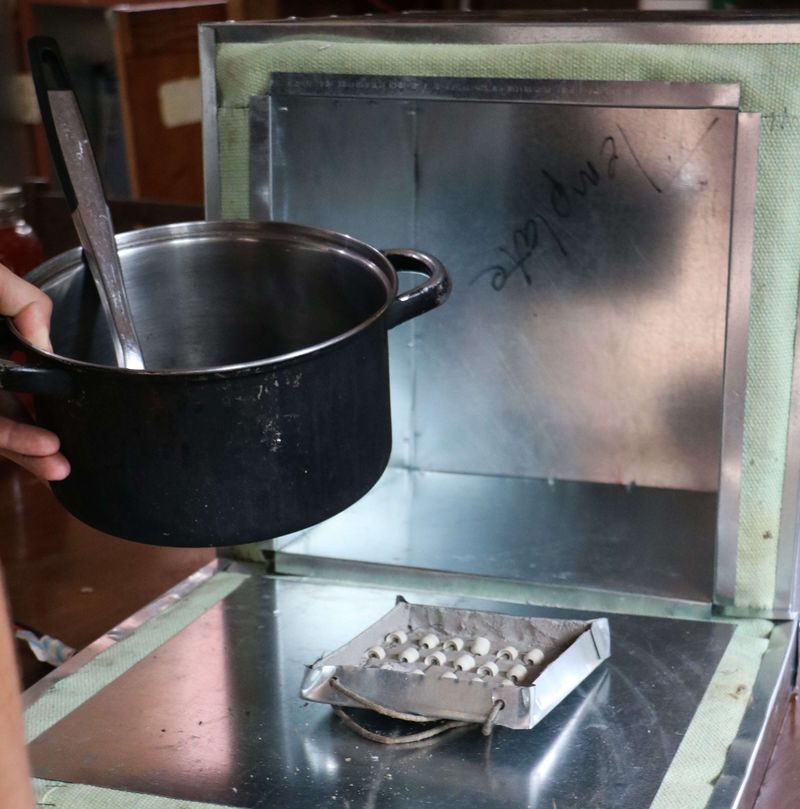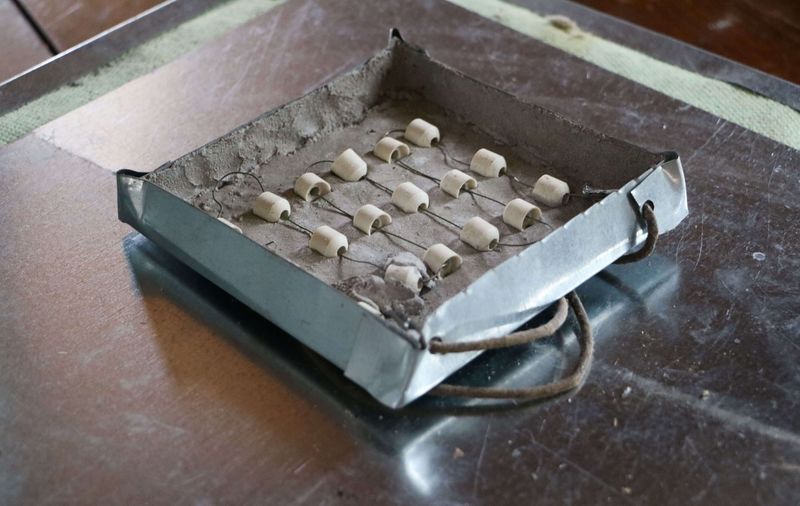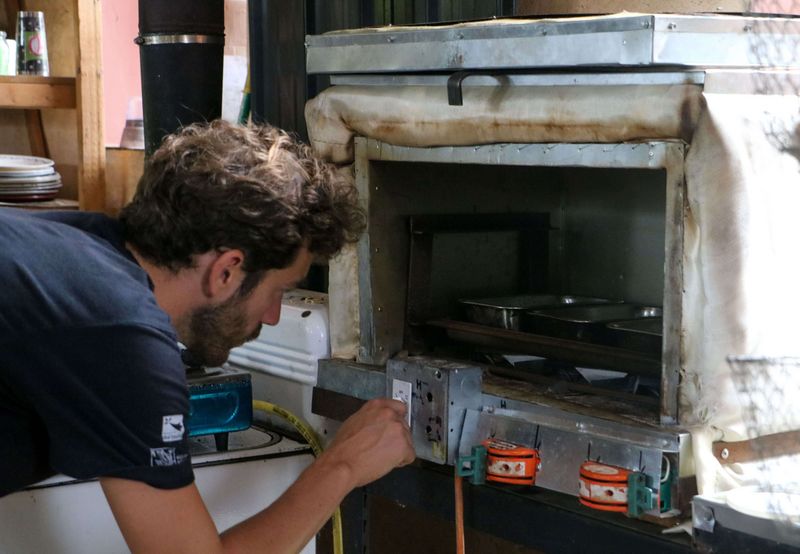Description
Insulated Solar Electric Cooker (ISEC) is an insulated electrically-heated cooking chamber, allowing the user to cook over a long period with low power from a solar panel, from the grid or from a combination that includes any electrical sources. Energy can be stored thermally or in a battery. Low-power cooking saves money by reducing electrical bills (if grid connected) or reducing the number of solar panels purchased. The simplicity of ISECooking technology allows it to be manufactured in locations where it is used.
Introduction
The ISEC project is born at CalPoly University in California thanks to Pete Schwartz and is now moving forward with collaborators all over the world.
This tutorial is based on the manual written by Alexis Ziegler from Living Energy Farm, a community in Virginia, US, seeking to operate without fossil fuels.
Background
According to the World Health Organization, 3 billion people in the world cook with biomass and coal; consequently, 4 million people die from associated emissions. In many communities, biomass cooking has lead to deforestation and can cause harmful pollution to the environment. Women are threatened by sexual assault when they leave their communities to collect firewood or purchase coal. The purpose of our research is to minimize the environmental impact and health issues that arise from biomass cooking.
Why Are These Solar Cookers Revolutionary?
“Normal” cooking involves using a lot of energy quickly, and very inefficiently. When you are cooking on a stove or in an oven, most of the heat is lost, not transferred to the food. The new cooking technology we are working with is called Insulated Solar Electric Cookers, or ISECs. These cookers are very efficient. At Living Energy Farm, we use solar power, and that makes us 100% energy self sufficient at the residential level. But unlike other off-grid projects, 90% of our electricity never goes through a battery. Rather, our solar electric panels send electricity straight to its useful destination. The Cal Poly team had the same idea, and ISECs use energy straight from solar panels. That makes the this way of using solar energy “radically inexpensive,” to use the term coined by the Cal Poly research crew. At a practical level, we have found ISECs to be more effective than any other solar cooking technology on the market. There are many solar cookers available, but ISECs are the most convenient to use, and provide by far the most effective means of solar cooking in sub-optimal weather. And they are cheap to build!
What to Expect
This technology is new and changing quickly. This document will tell you how to build ISECs. A materials source list is at the end of this document. The smaller ISECs function like a crock pot. All ISECs cook slowly, though the larger ones can cook somewhat more quickly. A 100 watt ISEC will cook 2 - 3 kg of food in winter or in partly cloudy weather, and more in sunnier weather. Larger ISECs will cook greater quantities of food. Slow cooking means less burned food, less carcinogenic substances in the food (which are created by very high temperatures), and more flavorful food. Slow cooking does involve changing the rhythm of cooking. Preparation is done ahead of time. ISECs could never replace all other cooking fuels in every climate, but they could do most of the cooking we need.
Community Scale Cooking
At LEF, we have built several biogas digesters, numerous solar cooking devices, as well as rocket stoves that use wood. Overall, a combination of biogas and ISECs seem to be the best approach to a cost effective, year-round, fully renewable approach to community scale cooking.The mix of biogas and ISECs is optimal because it allows cooking in any weather, is scalable to most any size, and can be adapted to most any climate. Biogas in a temperate climate is challenging because a biogas digester needs to stay very warm and cannot be indoors. And tending a biogas digester is like taking care of an animal -- you need to feed it every day, and pay some attention to it. That is easiest to do on a community scale.
The Value of Integrating Energy Systems
The original ISEC project developed at Cal Poly uses a 100 watt, 12 volt, well insulated cooker. The fact that they have proven that you can cook with only 100 watts is great! But such small power sources do not work in cloudy weather. We have found at LEF that our cooks always favor more powerful cookers. Our largest ISEC at LEF runs at 180 volts. It will cook quite well in cloudy weather. The ISEC project aims to provide inexpensive cookers for low income families all over the world. If 10 or 20 people can share a cooking facility, then it is possible to make much more effective cookers at higher voltages that work in cloudier weather, as well as providing other services, at a similar per-capita cost. The problem is, of course, that many low income communities do not have the up-front capital to build larger energy systems regardless of improved overall efficacy. The right balance of cost, efficiency, and scale is and will remain on ongoing question. Our hope here is to provide options.
ISECs Designs -- Your Options
The two types of cookers we have developed at LEF are bucket cookers and box cookers. The bucket cooker we call Perl is made with a 5 gallon bucket and perlite. The Cal Poly crew has expanded on this idea by using larger buckets with more insulation. For a small cooker, Perl works well. It is cheap and easy to build. It uses a stainless pot that can be removed from the cooker and can be any size up to about 6 quarts. The heat source is a homemade burner. It is also possible to build a bucket cooker can be built with wood ashes, though that’s not a great approach. Instructions follow. Our favorite cookers are Roxes -- box cookers made with rockwool sheet and sheet metal. Roxies can be built in many different sizes and insulation levels using rockwool and/ or fiberglass. Naturally, larger ISECs or ISECs with thicker insulation levels cost more. Roxies can use pots that you already have in your kitchen.Youtube
Matériaux
- High Temperature Wire: If you have heavy gauge wire around you can use it, but for short runs in the amperage needed for most ISECS, 14 - 16 gauge is fine.
- Metal Shears -- Brand name “aviation shears” are the best. Ideally, you want one straight cut
- Nichrome Wire
- Aramid or other non-flammable fabric
- High Temperature RTV Silicon
- Thermal Switches
- Heavier Aluminum Foil
- High Temperature Ceramic Beads
- Silicon Tubing, High Temperature (for steam venting)
- Inexpensive Wire Stripper/ Crimper/ Cutter
- Duct Metal
- Refractory Cement
- Rockwool Batts
- Aluminum Tape
Outils
Étape 1 - Construction Manual of Alexis Ziegler
Here is the link of the step-by-step construction manual to built the PEARL et the ROXIES cookers: https://conev.org/ISECmanual14.pdf
Here is the link to a construction video of an ISEC Burner : https://www.youtube.com/watch?v=uzZPstX1CbQ
Notes et références
Interview vidéo réalisé en août 2021 par Sidonie Francès et Guénolé Conrad.
Tutoriel rédigé par Guénolé Conrad.
- Pete Schwartz blog, compiling research advances on ISEC.
- Pete Schwartz Youtube channel reporting his experiments, in particular with thermal storage.
- Living Energy Farm website, gathering their feedbacks and manuals on their energy systems.
Published





 Français
Français English
English Deutsch
Deutsch Español
Español Italiano
Italiano Português
Português